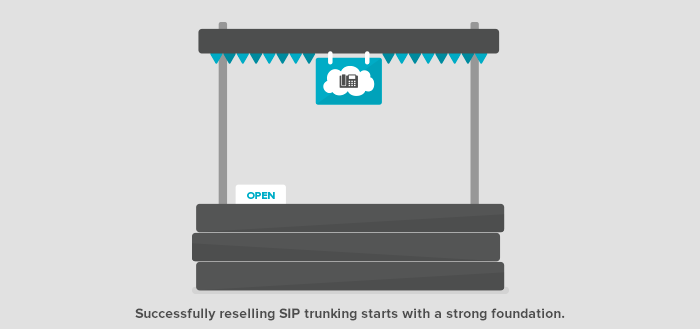Now that you’ve got the business side of SIP trunking ingrained in your brain, your empire only one step away. Granted it’s the most important part, the actual delivery of SIP trunking service. So pay attention to this one. Your empire is doomed without this critical knowledge. (Obviously.)
Really, there are probably at least 473 different models for building a company that resells SIP trunking. I’m going to tell you about 5 of them. Because they are the only 5 you really need to know to get started quickly and with little (or no) investment up front. Plus, three of them just happen to be a breeze to implement using Flowroute, so they’re what I know best. Once you have them nailed down, and pick the one that’s going to work for you, you can augment as appropriate.
The real trick (which isn’t a trick at all) is to make sure you know what you’re doing, or work with a provider that does. If you’re not sure how to set up a SIP server or provision phones, figure that out before you mess up your first customer and tarnish your reputation forever. The SIP School offers courses on just about everything you’ll need to become an expert.
Once you’re an expert, you’re ready to resell SIP in one of these ways:
1 – Manage your customer’s accounts.
From a management perspective, this is probably the easiest for starters, because the accounts and thus usage are conveniently organized in buckets. However, once your humble startup grows to empire-like proportions you might end up with too many accounts to manage billing and balances manually.
If you’re running on a prepaid provider (and you should, to limit your fraud liability) unforeseen spikes in customer traffic could dry out their account sooner than expected and they’ll be calling you from a payphone down the street yelling stuff like “get my phones working, you old so and so!” which case, it’s time for option two.
2 – Maintain one account.
In this case, you point all of your customers’ traffic through a single provider account you manage. From a balance management perspective, this option is the easiest. You have one account to keep in the black instead of n accounts, where n=your ever growing number of customers.
To keep calls straight, you can configure each device to attach x-tags to calls, which is an easy way to later sort calls based on customer for billing purposes. With x-tags embedded in your SIP records, you’ll be able to conduct a simple search to determine billing for each customer.
When you’re running all of your customers through one or two accounts, it’s also much easier to change providers as you see fit. So if a sweeter deal comes along, or one provider offers better inbound pricing but another’s outbound quality is far superior, you can split your traffic in multiple directions to maximize your profits. If you’ve set up each customer with their own account, a change-over becomes a monumental task.
3 – Affiliate programs.
Affiliate programs are basically rewards programs, providing incentive to funnel business toward a product or service. Under this structure, you’re essentially a marketing channel, not exactly a reseller.
Affiliate programs remove responsibility from your plate. The down side, is that as you give up responsibility, you also lose control. Which means, the quality of the service and support are out of your hands, and if the provider you’re working with changes course or sinks altogether, you are left searching for income all over again. And when your carrier goes down (or away for good), so does your reputation and payout.
Plus, as with any business model, less responsibility/risk yields less reward. In that sense, this option is often looked upon as a supplemental revenue stream rather than an entire business model.
4 – White-labeling.
Some will tell you this is the most plug and play option available. And is some ways it is. You find a provider, slap your logo on their GUI and coast your way to sipping margaritas on the Costa Rican coast while your SIP empire runs itself. You can even get customers to set up their own accounts.
When reselling a white-labeled solution, you have many options in terms of providers to choose from, and can choose the provider that fits best with your business plan. Make sure the features offered, billing and payout systems are up your alley.
A major drawback to white-labeling is that you’re now tied to one provider and their business. You’re essentially a sales channel for the SIP trunking provider you choose, and if they disappear one day, so do your customers’ phone lines. Plus, you lose control of your profitability. There is no variability in your cost. If you want to find more cost effective routes or features, you’re out of luck, your platform is set.
5 – Manage traffic through a switch.
Now, this might sound like option 2, but it’s actually a lot more involved, and gives you more control. In this case, you set up a switch through, say, FreeSWITCH or Asterisk, and send all your customers there before routing them through your SIP trunking provider. Going through a softswitch first requires more setup in the beginning but it allows you more control of features, and simplifies/automates billing. This also allows you to operate as more of a provider to customers. You can have endpoints connect directly to your switch in the cloud, rather than an on-prem PBX.
Using a module like A2Billing, which provides customer management with “flexible inline rating, and billing of calls and services in real-time”, builds more power into your platform as well as more technology and the corresponding maintenance. By going this route, you’re taking on more of the responsibility in the telecom delivery chain.
Find your balance.
Maybe there’s not one perfect model for you. We have customers working each of the first two options. And even some running both, or more, at the same time, creating multiple accounts that each serve multiple customers because they find it easier to manage. The trick is to find the balance that works for your business load.
Configure protection.
I’ve said it before and I’ll say it again, and probably again after that, VoIP fraud is a real threat. As mentioned above, work with a prepaid provider to limit your liability, because it’s your business on the line if cyber villains break in and spend like they’re in charge of the defense budget.
Also, set limits on outbound call rates and block high risk destination on your accounts, you can’t rely on all your customers to be careful with their network credentials. If they get hit by an attack, they’ll be looking to pass responsibility onto someone who looks a lot like you. One other protection you can create is to have separate accounts for domestic and international calling. There’s a good chance the majority of your traffic will be domestic. So you can put the lion’s share of your balance on the domestic account to limit your exposure to fraudulent international calling.
Hurry up about it.
You’re not the only one looking to quench the thirst businesses have for SIP trunking. IT integrators large and small are reselling SIP trunking. So are old school telecom consultants. AT&T, Comcast, CenturyLink, Verizon and big players also offer SIP trunking in some shape or form.
This is not the kind of thing you want to sit around thinking about for a few years. Develop a plan. Learn everything you can. Start establishing yourself as a dependable expert.
The secret to success is providing a reliable service backed up with strong service support. That means, know what you’re doing, and work with vendors you trust will ensure your customers’ phone calls are top-notch.
Yes, there is money reselling SIP trunking. It’s not always fast money. But it is as reliable as you set up your business to be. So get out there and sell some SIP. Businesses need you!







